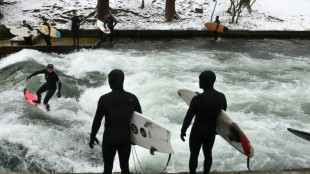
| CMSC | -0.68% | 23.51 | $ | |
| JRI | -1.46% | 13.68 | $ | |
| SCS | -0.06% | 15.83 | $ | |
| NGG | 0.38% | 75.025 | $ | |
| BCE | -1.91% | 22.245 | $ | |
| GSK | 0.99% | 46.815 | $ | |
| RIO | -3.57% | 67.945 | $ | |
| BCC | 2.11% | 69.815 | $ | |
| BTI | 0.71% | 52.815 | $ | |
| RBGPF | 0% | 76 | $ | |
| RYCEF | -1.52% | 15.13 | $ | |
| RELX | -0.1% | 44.125 | $ | |
| CMSD | -0.78% | 23.715 | $ | |
| VOD | -1.65% | 11.195 | $ | |
| AZN | 0.15% | 81.845 | $ | |
| BP | 1.36% | 35.35 | $ |
Reeling from earthquakes, Afghans fear coming winter

Survivors of a powerful earthquake that turned homes in Afghanistan into rubble are now wondering where they can they find shelter from pouring rain and the coming winter cold.
Others who made it through an even deadlier quake two months ago share their anxiety.
This week's 6.3-magnitude tremor that rattled the northern provinces of Samangan and Balkh killed at least 27 people, the Taliban authorities say.
The epicentre was located in Samangan's Kholm district, where a man named Gulabuddin is mourning his daughter-in-law.
When disaster hit overnight Sunday into Monday, she did not manage to reach the ground level of the family home in time.
Gulabuddin himself was hit in the head by a falling brick.
"We lost all of our belongings," he told AFP.
"Winter is coming. We have children aged four and five. Where can we go? For two nights now we've been staying with relatives."
Rain has turned a dirt path in his village into a muddy puddle, surrounded by cracked and collapsed walls and roofs that caved in.
Similar scenes emerged in areas of eastern Afghanistan that were struck by a shallow 6.0-magnitude earthquake in late August.
That one killed more than 2,200 people, making it the deadliest in Afghanistan's recent history.
In the farming village of Mazar Dara, in the mountains of Kunar province, Bazarga Safay saw children swept away as this earlier quake hit.
Two months later, she said she feared others would die of cold.
- 'Survive the cold' -
Safay, a 50-year-old farmer, lost two relatives in that earlier earthquake, and now shares a tent with 15 people, 12 of them children.
"We were given a tent, but it's not suitable for winter," she said.
Most residents prefer sleeping outside, in gardens or on terraces, fearful of spending the night in what remains of the village's houses as aftershocks are a frequent occurrence.
People will have to endure temperatures that will soon drop as low as -20C (minus 4 degrees Fahrenheit) without warm blankets or proper winter clothes.
"The earthquake happened in summer, and the organisations provided aid based on the needs at the time," said Najibullah Hanafi, a Taliban information official in Kunar.
"Now that winter is coming, they need clothes and things that can help them survive the cold."
Despite these dire conditions, international aid organizations have repeatedly warned that their work will be limited because major donors led by the US government have pulled funding.
- Concrete solution? -
At the foot of the mountain Mazar Dara sits on, camps have been set up.
But the International Organization for Migration says a survey among survivors showed that 77 percent of respondents indicated they planned to stay put even in winter -- either because they cannot afford to move or because they do not know where to go.
The only solution for many of them is to rebuild their homes but make them better, even at the cost of replacing the traditional stone houses.
Hanafi, the information officer, said the Taliban authorities were building dozens of new houses in Mazar Dara.
Correspondents there, however, saw only one bulldozer clearing debris.
"We need to rebuild right way, with concrete and bricks," said farmer Sayid Wali Safay, 27.
Another resident, Awal Jan, said: "We want to rebuild our house in the same place, but not in the same way. If we don't want our house to collapse again, only concrete will work."
I.Moreau--PS

 London
London

 Manchester
Manchester
 Glasgow
Glasgow
 Dublin
Dublin
 Belfast
Belfast
 Washington
Washington
 Denver
Denver
 Atlanta
Atlanta
 Dallas
Dallas
 Houston Texas
Houston Texas
 New Orleans
New Orleans
 El Paso
El Paso
 Phoenix
Phoenix
 Los Angeles
Los Angeles



